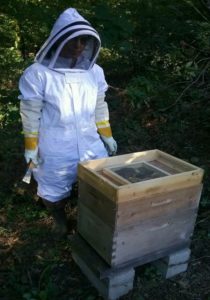Proper ventilation is important for bee colonies year round but can be especially critical in the winter. In the PNW, moisture, rather than cold temperatures, is a major contributor to decreased survival. Bees can amazingly well tolerate cold but less so when they are wet.
High hive moisture is due to the condensation of water vapor escaping from breathing, moving adult bees and brood, ripening of honey, breathing of wood – everything, it seems, gives off moisture. Moisture in excess in a hive is not a good thing.
Warmer air holds more water vapor than cold air. Warm air escaping from adult bees as they move about, seeking to keep warm, rises until it reaches the hive coverings. It can condense as drops on this surface and then drip down onto the bees below. Water dripping down onto the bees causes them to become even more active, resulting in escape of additional warm air and additional droplets condensing to, in turn, rain more water down on bees. A vicious downward spiral.
For best wintering, the warm moisture-laden air needs to be vented at the inner/top cover. Larger populous colonies, especially in early spring once the colonies start brood rearing in earnest after December, are more susceptible to this dripping water; smaller ones seem to do better.
In addition to the wetted bees, disease organisms, fungi, and molds thrive in moist environments. Wet bees are not as healthy as those in hives at sunny sites with proper hive ventilation.
Survey says
From the PNW survey, winterizing preparations make a difference. Any winterizing compared to none when related to overwinter loss was 9 percentage points less (18% better survival). When the winter management of use of insulted top or ventilation/quilt box utilized, loss rate was 33% compared to 40% overall for the 219 OR beekeepers returning a survey (an 18% improvement in survival). For the 28 WVBA members returning a survey, there was no difference in survival for those who used insulation or ventilation/quilt box at hive top compared to those who did not.
How to reduce moisture stress
As with much of beekeeping there are many ways to seek to reduce hive moisture. Drilling one-inch holes in boxes is a frequent remedy but not always successful. The hole may not be big enough to keep the interior dry, may be too low to vent moisture accumulations or the bees may seek to close the holes with propolis negating the beekeepers best intentions.
There are various moisture traps that can be used to seek to capture and wick off excess hive moisture. During winter, using one of this special rims (some term them Vivaldi boards or quilt boxes) or even just placing an empty hive body above the inner cover and placing a moisture absorbent substrates within the space to soak up the moisture can be useful. Compressed cardboard, crumpled newspaper, insulation, wood shavings, burlap, old towels/tube socks or straw/ hay are some of the materials used. Some items, like crumpled newspaper or wood shavings from pine, can become quickly saturated, depending on the weather, and may need to be replaced to prevent mold.
Rather than solid inner cover, replacing the wood/Masonite with screen covers greatly improves airflow. Using shims under top covers, carpet tacks, wooden (Imirie) shims, a twig or stone can also help vent the moisture laden air. This will also need be done with removal of the usual propolis seal gluing the covers to the rim of the top hive box. The shims prevent the outer cover from lying flat against the boxes/screen. The damp air can flow from the hive, up through the screen, and out the space on either side.
One other management that helps reduce potential moisture stress is to switch to feeding of dry sugar versus use of a syrup, when still needed after the end of October. Candy boards or using dry sugar on the inner cover is best once our winter closes in. Others prefer a partially converted sugar source such as fondant or drivert sugar (both of which do not harden as solidly as cane or beet sugar does), although more expensive, is the choice of some individuals. Once flight conditions improve we can return to liquid feeds in the spring.
However it is accomplished, good bee stewardship management to AVOID/REMOVE EXCESS MOISTURE can improve winter survival. Photo shows ventilated (screened bottom) board at top of colony replacing inner cover (add top cover). Inner square screen box confines bees to hive – you can place dry sugar within this square.

